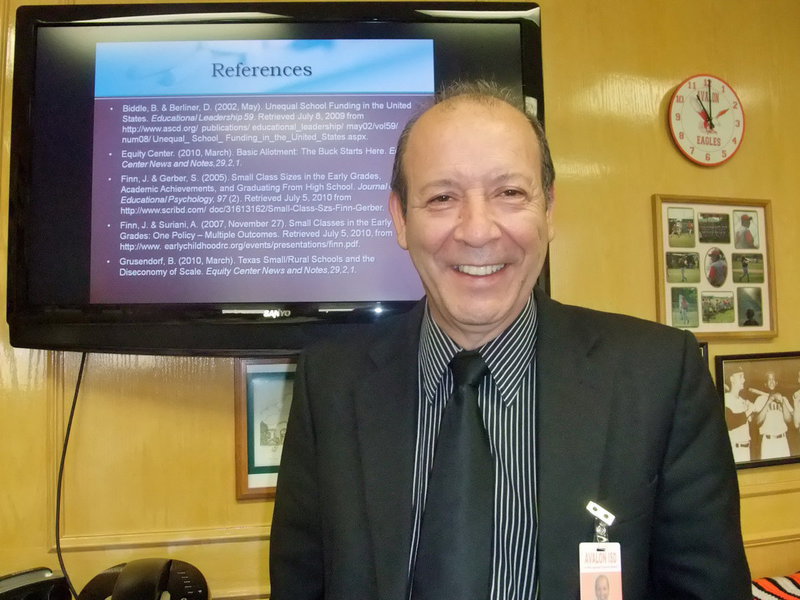David Del Bosque speaks out about school funding
David Del Bosque — David Del Bosque truly cares of his students and all students. He would like to see fair funding for all students. (Cindy Sutherland)
David Del Bosque (Avalon ISD Superintendent) is a member of Texas Association of Rural Schools. Last week Del Bosque was in Lubbock, Texas attending one of the conferences the Association puts on throughout the state. He did a presentation called Texas Public School Funding, The Target Revenue System and the Effect on a small District-Avalon ISD. He expressed his concern for the rural schools and he talked about how legislators need to make education a priority. His presentation focused on school funding and why it needs to be changed.
The presentation began with the demographics on the Texas Public Education System. He explained that there are 1,300 school districts-1025 independent school districts, 275 charter schools, military and special districts; 646,815 school employees and 327,663 teachers. There are 4.8 million students (20% growth from 99-10)-2,853,177 (58.9%) economically disadvantaged in Texas schools, 1.8 million children in Texas itself under the age of 18 below poverty level, 1/2 million in Rural schools and Approximately 400,000 in schools less than 1600 students.
Del Bosque said, "The funding system is broken. It is not adequate and neither is it equitable. In my opinion it is grossly unfair how things are funded. He explained, “The whole funding system started back in 2005 when districts filed a law suit contending the state had not met its constitutional duty by providing necessary funding for mandatory programs (West Orange-Cove vs. Neely (2005). Two thirds of school districts were within five cents of the $1.50 Maintenance and Operations tax maximum allowed. The court ruled that the $1.50 tax cap was in essence a state tax and removing meaningful discretion, thus unconstitutional and ordered a remedy.”
“So, House Bill One was a remedy in 2006. That is how they fixed it, they reduced the property taxes from a dollar fifty to a dollar. So ultimately they reduced it by one third. What happened is it was phased in over two years. So, they call it the “compressed tax rate”. So, if you are at 1.50 in 2005, they multiply that by 66.67 percent. Which means that your tax rate went from a dollar fifty to a dollar, that is why your taxes went down. What it did is called a “Target Revenue”. Target revenue basically is the state guarantees schools that you will not receive any less money than you were receiving before this new law, so, the state made up the difference. Because the school is saving 1/3 less of taxes it was reduced by a 1/3 and so the state said you will not receive less than what you were receiving."
“This is the whole concept of Targeted Revenue. It is revenue per student, so in effect the revenue for schools was frozen at either the 2005 or 2006 levels – which ever would give you the most money. That is called whole hold harmless revenue and since property taxes were reduced the state held harmless the funding the school district received in order to insure that they would not receive less funds because of the new measure. To insure the district will not loose funding, the state would make up the difference.”
Del Bosque went on to say, "Now we have ‘Inverse Effect’. I am not sure if people understand what that is. Your revenue is frozen – you can’t get less than what you got in 2005 but you can’t get more either. Inverse effect means the revenue is frozen- if property values go up, the state contributions to the district go down proportionately dollar for dollar. So, the result is like, if the value of your house increases or if property values increase, or say if there is a big growth in Italy or Avalon, we are not the beneficiaries of it. We may collect more in local taxes but the state is going to reduce their contribution. It stays the same, you can’t make any less and you can’t make any more. So if your community has growth you don’t benefit from it, the state does because they reduce what they pay. Each school has a Target Revenue. Target revenue funding is the amount of money you get for each student. Target Revenue varies from a low of $3,800.00 to a high of $13,000.00 per student. So not everyone gets the same amount of money. Avalon’s Target Revenue is $4,755 per student. So what is the effect? With one thousand twenty five school districts in Texas, Avalon has the 31st lowest funding per student. As an example, in Austin they have a Target Revenue of 6,100 dollars which is $1,300.00 more per student which in effect comes out to $26,900 more for every classroom of 20 students. This unfairness is everywhere. It is not just in Avalon. The state average is $5,455.00, Austin is $6,100.00 Avalon is $4,755.00.
In conclusion Avalon and all districts are expected to meet all new mandates and expectations. All children deserve access to the same level of funding.
Del Bosque concluded with, “Our children’s hopes, dreams and aspirations are no different than any others. Yet funding for these same hopes, dreams and aspirations are funded differently.”

